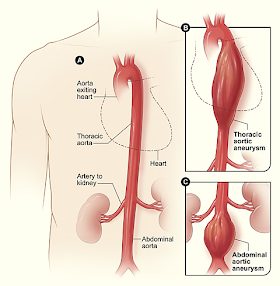How Long is the Recovery Period After Aortic Aneurysm Surgery?
Aortic aneurysm surgery, also known as aortic aneurysm repair, is a significant procedure to prevent the potentially life-threatening rupture of the aorta, the body's main artery. Patients undergoing this surgery often wonder about the recovery period and what to expect post-operation.
What is Aortic Aneurysm Surgery?
Aortic aneurysm surgery involves repairing an enlarged or weakened section of the aorta to control rupture. This procedure is crucial as a ruptured aortic aneurysm can lead to severe internal bleeding and is often fatal if not treated promptly.
Recovery Timeline:
The recovery period after aortic aneurysm
surgery can vary depending on several factors, including the patient's
overall fitness, the type of surgery performed, and any complications that may
arise. Here's a general timeline:
- Immediately After
Surgery (Hospital Stay): After the surgery, patients typically spend
several days in the hospital's intensive care unit (ICU) for close
monitoring. This initial phase focuses on stabilizing the patient and
ensuring no immediate complications.
- First Few Weeks:
During the first few weeks post-surgery, patients may experience fatigue,
discomfort at the incision site, and some pain, which is managed with
medications. Following the doctor's instructions regarding rest and
activity levels during this period is essential.
- First Three Months:
As time progresses, most patients gradually regain strength. They may
begin to resume light activities under medical guidance but should avoid
heavy lifting or strenuous exercise until cleared by their doctor.
- Long-Term Recovery: Full recovery from aortic aneurysm surgery may take several months to a year. Follow-up appointments are crucial to monitor healing and address any concerns that may arise.
What Factors Influence Recovery?
Several factors can influence the recovery period after aortic aneurysm
surgery:
- Overall Health:
Patients with pre-existing conditions such as heart disease or diabetes may recover
longer.
- Type of Surgery:
The complexity of the surgery performed (open repair vs. endovascular
repair) can impact recovery time.
- Complications: Any complications during or after surgery, such as infections or blood clots, can prolong recovery.
Post-Surgery Care and Lifestyle Adjustments:
To aid in recovery and lower the risk of future complications, doctors
often recommend lifestyle adjustments such as:
- Medication
Adherence: Following prescribed medications to manage pain, prevent
infections, and control blood pressure.
- Healthy Diet:
Eating a level diet low in salt and saturated fats to promote heart
health.
- Regular Exercise:
Gradually reintroducing physical activity as advised by healthcare
providers to improve overall fitness and circulation.
- Monitoring: Attending regular follow-up appointments with the aortic aneurysm doctor to monitor healing progress and detect any potential issues early.
Understanding the recovery period after aortic aneurysm surgery is essential for patients and their families. By following medical advice, taking prescribed medications, and making necessary lifestyle adjustments, patients can support their healing and decrease the risk of future complications.
For anyone facing aortic aneurysm surgery, knowing what to expect
during recovery can help alleviate concerns and prepare for the journey ahead.
Consult a qualified aortic aneurysm doctor to discuss individualized recovery
expectations and care plans.


Comments
Post a Comment